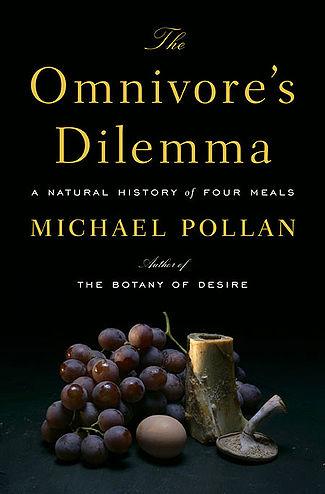I am calling it The Pure and Simple Book Club. It is pretty self explanatory but the idea is that after I read a book that I think is worth discussing I will give you the break down and what I think of it (the good, the bad, and everything in between).

If you follow me on Facebook you may have already heard me raving about the first book in the book club: The Omnivores Dilemma by Michael Pollan. Now before I go any further I should mention that I have not been paid to write this post, nor was the book donated to me. I bought this book with my own hard earned money (I think at GoodWill to be honest) and am writing this review for the sole purpose of spreading information that I believe is extremely important. However, if you do purchase the book through the links in this post I will receive monetary compensation which helps me to keep the blog going (and I THANK YOU for it).
 The Omnivores Dilemma by Michael Pollan
The Omnivores Dilemma by Michael Pollan Ok moving on….
First of all I just want to say that I loved this book! So much so that I may even read it again (after I make everyone in my family read it of course). I like to believe I am fairly educated when it comes to food, and where it comes from… but this book just proved how much I still don't know.
The description of this book is "A Natural History of Four Meals", and what it entails is a field to plate analysis of where our food comes from, and what happens to it along the way. The good, bad, and the ugly (unfortunately it's mostly ugly). And Michael Pollan has a way of writing with subtle sarcasm that keeps you entertained and intrigued through the whole read.
Obviously I cannot outline the entire content of the book here, but I will highlight some of the information that I thought was particularly interesting.
One topic that is covered very well is the description of how, in the last 50-70 years, the government and large corporations have put in place policies and laws aimed at transforming what once was food into a series of chemicals that we have come to think of as "food". And how this whole industry has been made possible by the huge expansion of corn and corn products (as well as soy and petroleum products). And this reliance on one or two main crops has since lead to significant damage to our soils, ecosystems, other agricultural practices, and the famers producing these crops. And while logically, changing to this dangerous, environmentally damaging process doesn't seem to make sense, Michael does an excellent job of researching the issue from all angles to make the reader truly understand how this system continues to be promoted.
As you already know, I think it is very important for people to know where their food is coming from. And while that may not be possible 100% of the time, unfortunately most people have no idea how their food is made, and what is going into it. And it is this way on purpose. The government and the food industry don't want you seeing the horrific conditions that animals are kept in, the "food" they are fed and they way your food is prepared. Because it isn't pretty;
"The industrialization - and brutalization - of animals in America is a relatively new, editable, and local phenomenon: No other country raises and slaughters its good animals quite as intensively or as brutally as we do. No other people in history has lied at quite so great a remove from the animals they eat. Were the walls of our meat industry to become transparent, literally or even figuratively, we would not long continue to raise, kill, and eat animals the way we do. Tail docking and sow crates and beak clipping would disappear overnight, and the days of slaughtering four hundred head of cattle an hour would promptly come to and end - for who could stand the sight?"
Now there are extensive descriptions in the book of the conditions that the animals that end up on our plates are kept in. I won't detail them here, but trust me when I say they are horrifying. They will make you think twice about eating that conventionally raised steak on your plate.
Another topic that really hit home for me was the cost analysis component of eating. One of the main objections that I hear when I encourage people to buy local, ethically raised, and grassfed meat products is that "it is so expensive." And yes I agree that it does cost more. But that only considers the upfront costs. This book provides interesting arguments to counter this belief:
Yes it may seem cheaper in the store, but have you considered the cost that this type of meat is having in the long run?
For example, the healthcare costs? Healthcare is one of the biggest expenses for both Americans and Canadians, and the negative health effects that factory farmed meats are having on the population through increased rates of obesity, heart disease, diabetes, autoimmune diseases, cancer etc. is only contributing to these costs (and hence your personal spending, productivity, and tax dollars). Or the government subsidies that are going into producing this meat and thus the tax dollars you are putting towards these products? Or the antibiotic resistance that this meat is breeding, and thus costing people in terms of health and potential superbugs?
The book also points out that cost is a relative factor; in the 1950's Americans used to spend 50% of their disposable income on food, whereas that number is now closer to 10-25%. People's lifestyle expectations have changed, and instead of spending their money on food, people are now spending their money on other things like clothes, cars, homes, technology, beauty products, etc etc. It may be that we need to start shifting our expectations back to what they were 50 years ago in order to spur real change in the food industry (I know I could benefit from this shift… Do I really need yet another new dress?).
These are just a few examples of the arguments raised in the book. Michael Pollan does a much better job of discussing these issues, plus many more.
After describing where exactly our food comes from Michael Pollan then goes on a quest to create his own meal, entirely with items he collects himself (including killing a wild pig). It really makes you realize just how much effort goes into making a meal, and how we take this for granted with the huge separation between the food industry and us as the consumers. I am not sure if I would be able to kill my own meat for dinner, so I really do appreciate the effort Michael took in writing this book, and it makes me appreciate even more the local farmers who I buy my meat from.
Now I realize I have already written a lot, and I could go on and on with much more detail, but I will leave it here. I hope I have shared just enough so that you will be intrigued to read this book yourself. Education is power, and we can't expect anything to change unless we change our own behavior and buying habits.
I will leave you with one last quote from the book which really resonated with me:
"We don't need a law against McDonald's or a law against slaughterhouse abuse - we ask for too much salvation by legislation. All we need to do is empower individuals with the right philosophy and the right information to opt out en masse."
Please let me know what you think of this post! Have you read this book? Will you read it now?
What book would you like to see next reviewed?
The Omnivores Dilemma can be bought here.
As always if you have any comments or questions please don't hesitate to contact me! I love hearing from you guys.
